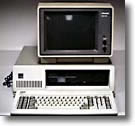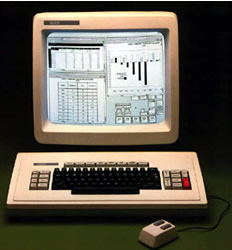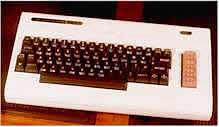click on the home button to go to the thocp home page
|
The Industrial Era 1981 Microsoft's monumental error: 640Kb (see discussion) IBM brings out an early version of an office computer. The first portable computer from Osborne. And he famous Commodore Vic 20 that sold over 20 million pieces. The first adventure game Zork appeared a fore runner of Dungeons and Dragons. |
pre history | antiquity |
pre industrial era | industrial
era
| 1947 | 1950 | 1952 | 1955 | 1958 | 1961 | 1963 | 1965 | 1969 | 1970 | 1972 | 1974 | 1976 |
| 1978 | 1980 | 1981 | 1982 | 1984 | 1986 | 1989 | 1991 | 1993 | 1994 | 1996 | 2000 | 2002 |
| Related Articles |
| Related Resources |
| pre history |
history of videogames |
![]() The
director of Canada's Radiation Protection Bureau declares that video display
terminals carry no radiation hazard.
The
director of Canada's Radiation Protection Bureau declares that video display
terminals carry no radiation hazard.
![]() Microsoft
reorganizes into Microsoft Incorporated, with Bill Gates as President and Chairman,
and Paul Allen as Executive Vice President. Later in the year it is renamed
Microsoft Corporation.
Microsoft
reorganizes into Microsoft Incorporated, with Bill Gates as President and Chairman,
and Paul Allen as Executive Vice President. Later in the year it is renamed
Microsoft Corporation.
In July Microsoft bought all rights to 86-DOS from Seattle Computer Products
(system) then called QDOS - assumingly meaning Quick and Dirty Operating Sytem,
and the name PC-DOS is adopted. Soon thereafter, in August, Microsoft released
their version: MS-DOS version 1 operating system. This OS used 160 Kb memory
and read single sided floppy discs.(25)
When Microsoft DOS 1.0 was released the program consisted of about 4000 lines
assembler. And three programs were forming the base: command, sys, iosys.
With some supplementary programs like Format(43)
and Edlin(44). This tandem setup - IBM-PC en MSDOS
- will soon become the international standard for micro computers.
In these early years Microsoft and IBM engineers thought that a program of some ten's of kilo bytes was a big one. Later experience showed that the memory hunger of software would be unimaginable and that the 640 K barrier caused enormous problems.
|
Another Famous "He could not be wrong more": "640K ought to be enough for anybody." Bill Gates, 1981 (see discussion) |
IBM did not expect financial wonders of this PC. And the experts foretold an
early death. How could they be wrong more! The concept of the PC was a gigantic
success but one of the most important factors was that IBM published the technical
specifications.
IBM selected the 8088 CPU of Intel for its platform, this decision was primarily
influenced by the high price of Motorola's 16-bits 68000 processor. (40)

![]() IBM introduced its first desktop computer, the
Datamaster. It uses a 16-bit 8086, and was a dedicated data processing machine.
Initial costs 3000U$.
IBM introduced its first desktop computer, the
Datamaster. It uses a 16-bit 8086, and was a dedicated data processing machine.
Initial costs 3000U$.
![]() Apple Computer introduced its first hard drive,
the 5MB ProFile, costing USD 3500.
Apple Computer introduced its first hard drive,
the 5MB ProFile, costing USD 3500.
![]() Novell Data Systems shiped the Novell Data Management
Computer, with the ability to share its hard drive space with other computers
through software control and network cards.
Novell Data Systems shiped the Novell Data Management
Computer, with the ability to share its hard drive space with other computers
through software control and network cards.
![]() College professor James Clark founded Silicon Graphics
College professor James Clark founded Silicon Graphics
![]() Intel and Advanced Micro Devices agreed to collaborate
on the design and production of new products.
Intel and Advanced Micro Devices agreed to collaborate
on the design and production of new products.
![]() Apple Computer prohibited mail-order sales of Apple
computers, claiming there is no provision for customer education or services.
Apple Computer prohibited mail-order sales of Apple
computers, claiming there is no provision for customer education or services.
![]() The first IBM PCs rolled off the assembly lines.
The first IBM PCs rolled off the assembly lines.

 12th of August, IBM showed its IBM 5150 PC
(personal computer) that is based on the 4.77 MHz 8 bit 8088 CPU of Intel 64KB
RAM, 40KB ROM, one 5.25-inch floppy drive (160KB capacity)
12th of August, IBM showed its IBM 5150 PC
(personal computer) that is based on the 4.77 MHz 8 bit 8088 CPU of Intel 64KB
RAM, 40KB ROM, one 5.25-inch floppy drive (160KB capacity)
![]() At
the same time IBM introduced Microsoft's DISK OPERATING SYSTEM (MS-DOS) called
PC DOS 1.0 by IBM. This program would operate the new IBM PC.
At
the same time IBM introduced Microsoft's DISK OPERATING SYSTEM (MS-DOS) called
PC DOS 1.0 by IBM. This program would operate the new IBM PC.
The sales price of the IBM PC was high: from 3000 to 6000 USD, depending on the configuration.
It was particular for this PC that it has been build from 'off the shelve'
parts. Parts that could have different origins.
Here the term OEM was introduced: meaning Original Equipment Manufacturer. In
the machine could be disk drives from Japan, the CPU from Intel and memory from
Samsung (Korea)
The first PC's were sold with 64Kb RAM (64.000 characters) with the option
to expand to 256Kb, a very limiting memory as will be clear later. The first
model of the IBM PC had a tape recorder as external memory. Only later to be
replaced by 180Kb 5.25" diskdrives for an exorbitant price of 800 dollar.
At left you see a 256Kb model "fully loaded". The color monitor was
introduced a few years later.
The development of the IBM PC took just about a year mainly because of the spin-off
of other (failed) projects.
IBM published all technical data on the ROM BIOS(45)
and Operating system, choosing for a so called open architecture for their micro's.
This would make it possible for other manufacturers to create"standard"
MS-DOS compatible machines. These were the so called "clones". Thart
this rised the question of compatibility, a big problem at that timem, left
no doubt. Incompatibility was caused off course in part by patents held by different
companies, such as IBM, but also by other (export) restrictions.

![]() RANK-XEROX
- Intel and Digital released (in combination) the Xerox Star (8010), nick named
"The Office".
RANK-XEROX
- Intel and Digital released (in combination) the Xerox Star (8010), nick named
"The Office".
"This was the system that launched a thousand innovations" will be
said later on.
It is the first commercial computer with Windows, Icons, Mouse and Pull-down
menu's - the so called WIMP interface. Later the term GUI(46)
replaced that name
This machine meant an enormous leap forward in terms of user friendliness and
the interaction of Human-Machine. The concept was good, but elements like: marketing,
an extreme high price (50.000 US$), the dependence on a network and the size
of the machine made the Xerox 8010 unwieldy for the individual user.
Again Xerox was far ahead of its time, but the consumer did not want a refrigerator size machine in his office or work room
The best brains worked on the design at the now legendary laboratories of Xerox PARC(47). many of their inventions are now used on all GUI oriented machines. But the STAR did not become a success simply because of its price and size. Later on the Apple Lisa and MacIntosh interfaces would contain many of the innovations invented at Xerox's PARC.(41)
![]() From
Japan Matsushita (known by Technics and Panasonic) released a Magnetron with
a six inch screen and a tapedrive. All kind of recipes were stored and pronounced
via a voice synthesizer. One could also give commands by voice. The cooking
progress could be tracked via the six inch screen. The innovation on itself
was very advanced but apart from being exotically expensive, the machine was
also very inept in recognizing one's voice. Many technical problems were not
fully solved. It will have to wait until 2000 before a fully functional "kitchen
machine" will be introduced by Siemens. (also see Honeywell'd kitchen
computer in the 60's)
From
Japan Matsushita (known by Technics and Panasonic) released a Magnetron with
a six inch screen and a tapedrive. All kind of recipes were stored and pronounced
via a voice synthesizer. One could also give commands by voice. The cooking
progress could be tracked via the six inch screen. The innovation on itself
was very advanced but apart from being exotically expensive, the machine was
also very inept in recognizing one's voice. Many technical problems were not
fully solved. It will have to wait until 2000 before a fully functional "kitchen
machine" will be introduced by Siemens. (also see Honeywell'd kitchen
computer in the 60's)
![]() The
developers of CP/M reacted to MS-DOS with CP/M 86. A 16 bit system and backward
compatible with the 8 bit CP/M version.
The
developers of CP/M reacted to MS-DOS with CP/M 86. A 16 bit system and backward
compatible with the 8 bit CP/M version.
![]() The
USCD Pascal p-system is introduced. Called an interactive Pascal interpreter
that offered excellent portability for software development. Meaning that the
code could be recompiled on other machines and presumingly do the same thing.
The
USCD Pascal p-system is introduced. Called an interactive Pascal interpreter
that offered excellent portability for software development. Meaning that the
code could be recompiled on other machines and presumingly do the same thing.
![]() Warner Anex., Atari and CompuServe announced the cable TV information
service.
Warner Anex., Atari and CompuServe announced the cable TV information
service.
![]() IBM's Color Graphic Adapter (CGA) video card was introduced.
IBM's Color Graphic Adapter (CGA) video card was introduced.
![]() Creative Technology was founded in Singapore, and will become a leading
manufacturer of sound-cards.
Creative Technology was founded in Singapore, and will become a leading
manufacturer of sound-cards.
![]() Sony
introduced the 3.5" diskette with a capacity of app. 800 Kb. This format
could not be read on a micro computer with an MS-DOS system. But it soon was
the world standard storage medium for Apple and Hewlett Packard machines.
Sony
introduced the 3.5" diskette with a capacity of app. 800 Kb. This format
could not be read on a micro computer with an MS-DOS system. But it soon was
the world standard storage medium for Apple and Hewlett Packard machines.
![]() Memory
chips were getting cheaper and a 64Kb RAM chip became the defacto norm.
Memory
chips were getting cheaper and a 64Kb RAM chip became the defacto norm.

![]() The first Portable Computer of Adam
Osborne, the Osborne I, was introduced. This computer weighed only 12 kilo and
it ran on the CP/M OS. It included a Z-80 microprocessor, a 5" display,
64 Kb RAM, a keyboard, two serial ports, two 5.25" Disk Drives. The machine
was relatively cheap: 1795 US$. The most important thing was that Osborne was
the first to offer his machine bundled with software that valued almost 1500
US$. The package contained WordStar, Supercalc, BASIC and a lot of CP/M utility
programs.
The first Portable Computer of Adam
Osborne, the Osborne I, was introduced. This computer weighed only 12 kilo and
it ran on the CP/M OS. It included a Z-80 microprocessor, a 5" display,
64 Kb RAM, a keyboard, two serial ports, two 5.25" Disk Drives. The machine
was relatively cheap: 1795 US$. The most important thing was that Osborne was
the first to offer his machine bundled with software that valued almost 1500
US$. The package contained WordStar, Supercalc, BASIC and a lot of CP/M utility
programs.
But Osborne made one crucial error in marketing: he announced the second model the Osborne II when there was still a huge stock of Osborne I types. Sales dropped dramatically and Osborne filed for bankruptcy soon after.(42)

![]() The famous VIC20 was released by Commodore
with a full-sized 61-key plus four function keys keyboard, 5KB RAM expandable
to 32KB, 6502A CPU, 22 character by 23 line text display, and color graphics.
The first color computer that is affordable costed only 300 US$. The production
peaked at 9000 units per day. Phenomenal for this time! It became the first
million-seller model in history.
The famous VIC20 was released by Commodore
with a full-sized 61-key plus four function keys keyboard, 5KB RAM expandable
to 32KB, 6502A CPU, 22 character by 23 line text display, and color graphics.
The first color computer that is affordable costed only 300 US$. The production
peaked at 9000 units per day. Phenomenal for this time! It became the first
million-seller model in history.
![]() The
first adventure game "Zork" was published. Though the openings screen
raised a big expectation the game was completely text (character) based.
The
first adventure game "Zork" was published. Though the openings screen
raised a big expectation the game was completely text (character) based.
It played like:
You are standing in front of a closed door. Next to it you will find a letterbox. What will you do.>_
The player had to type in his or her answer and press enter. Then the next question or suggestion came from the computer and the player typed and typed...
The fantasy of the player had to be a vivid one. But is was sure a lot more
fun than Pong and Spacewar.(48)
The original 'Zork' was written in 1977-79 at the MIT (USA) by a group including
Marc Blank and Dave Lebling. It was programmed in MDL but ported (translated)
to FORTRAN (and renamed 'Dungeon') by Bob Supnik in 1979/80. This is a TADS
port of the FORTRAN port (based on Dungeon v3.1)(49).
![]()
| Last Updated on October 25, 2004 | For suggestions please mail the editors |
Footnotes & References